Trigger Based Email Marketing
Table of contents
- Triggered Email Marketing Campaigns
- Simple Trigger-Based Email Marketing Example
- Common Triggers:
- Benefits of Triggered Email Marketing
- Essential Triggered Email Flows
- Strategies for Implementing Triggered Email Campaigns
- Common Mistakes to Avoid
- Tools for Triggered Email Marketing
- Successful Triggered Email Campaigns
- Measuring Success in Triggered Email Marketing
- Wrapping Up
TL;DR: Triggered Email Marketing Campaigns Key Takeaways
- Triggered email marketing automates customer communication, saving time and streamlining workflows.
- Customizing emails using customer names, preferences, and behaviors enhances engagement and builds trust.
- Timely, relevant emails drive more sales by guiding customers through their journey.
- Maintaining strong relationships with follow-ups and re-engagement strategies, reduces churn.
- Welcome, abandoned cart, post-purchase, re-engagement, and behavioral emails cover all stages of the customer journey.
- Use clear CTAs, engaging subject lines, and dynamic content to create converting emails.
- Don’t spam; prioritize data privacy and quality over quantity in your email campaigns.
- Track metrics like open rates, click-through rates, conversions, and revenue to optimize performance.
- Use platforms like Klaviyo, Mailchimp, ActiveCampaign, Omnisend, or Tabular.email for effective automation.
Triggered Email Marketing Campaigns
There is not a single doubt that email marketing offers numerous benefits. However, manually sending emails to every single customer for each step of the process would require an entire operations team dedicated solely to this task. Fortunately, mail automation systems and trigger based email marketing have revolutionized this process by automating emails precisely when they are needed.
Consider the various steps a customer goes through when purchasing a product. They may expect notifications for subscribing to emails, making a new purchase, successful payment confirmation, shipment details when the order is ready, and so on. Each of these steps represents a trigger. By adopting a trigger email marketing strategy, you can automate these triggers and send corresponding emails effortlessly.
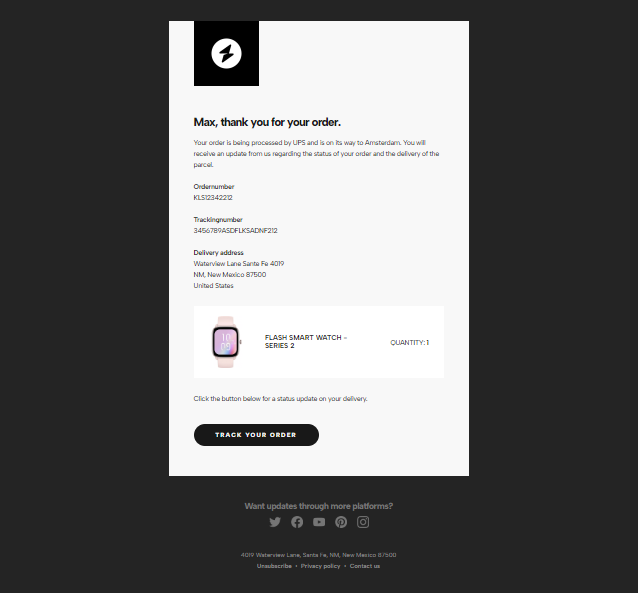
Technology is designed to simplify our work, not to keep us glued to screens tracking every customer's journey. In this article, we’ll explore how you can seamlessly integrate trigger technology into your email marketing campaigns.
What Are Triggered Email Marketing Campaigns?
Trigger-based email marketing campaigns are automated emails sent in response to specific user actions or events, such as sign-ups, purchases, or cart abandonment.
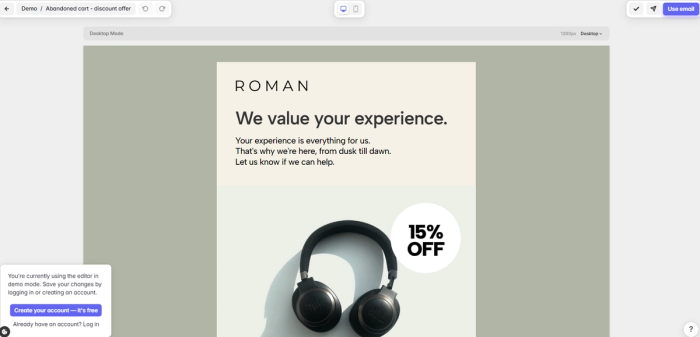
Since transactional emails are the type with the highest open rates, they can also be used for promotion by including personalized offers, discounts, or product recommendations based on user behavior, such as after a purchase or during cart abandonment.
Put simply, any email scheduled to be sent at particular customer milestones falls under trigger campaign email marketing.
Simple Trigger-Based Email Marketing Example
| Day | User Action | Email Type |
|---|---|---|
| Day 0 | User signs up for the service | Welcome email with introduction to features and benefits |
| Day 1 | User browses products but does not purchase | Personalized product recommendations or a 'still looking?' email |
| Day 3 | User adds items to the cart but abandons it | Cart abandonment email with a discount or reminder to complete purchase |
| Day 7 | User has not engaged with previous emails | Re-engagement email with a special offer or 'we miss you' message |
| Day 10 | User makes a purchase | Thank you email with order confirmation and cross-sell suggestions |
Common Triggers:
Through specific customer behaviors and patterns, your automated emails get triggered and sent to your recipient. Here are some of the most common triggers:
- A welcoming email notifying a user of their successful sign-up or submission is often the starting point of the customer journey.
Create your template using our email template builder.
- When a purchase remains incomplete and items linger in the cart, you can send a reminder email. By setting a specific time frame, such as a day or a week, you can automate this email to encourage action.
Create your template using our email template builder.
- Analyzing customer behavior on your website and tracking patterns can help convert browsing into sales. However, it’s crucial to avoid coming across as a pushy salesperson constantly hovering in the background.
Create your template using our email template builder.
- Emails also serve as a written record of your agreement with the customer. For instance, sending notifications about successful payments or order confirmations can help customers track their purchases more effectively in their email inbox.
Create your template using our email template builder.
- Inactivity can harm your relationship with customers and negatively impact your sender reputation. If customers stop opening or responding to your emails, you have two options: attempt to re-engage them with targeted campaigns or send a final email notifying them of their removal from your email list.
Benefits of Triggered Email Marketing
Scalable Personalization
One key distinction between social media marketing and email marketing strategies is the ability to personalize messages at any scale.
By simply addressing customers by name, referencing their interests, or highlighting products they might like, you can create messages based on user behavior.
With advancements in AI technology, there’s no need to manually analyze individual customer preferences. Instead, you can create personas and segment your audience accordingly for more precise targeting.

Improved Engagement
To measure the success of your email marketing efforts, it’s essential to track key metrics such as open rates and click-through rates.
To boost engagement, analyze these metrics, compare them with your other campaigns, and identify areas that need improvement.
Constantly conducting A/B tests with your email templates and experimenting with different CTA designs will increase the ROI of your email marketing campaigns.
Increased Conversions
Triggered email marketing helps boost conversions. Consistent and timely messaging builds trust and encourages purchases through relevant and well-timed emails.
Efficient Automation
Planning all your emails at once can feel overwhelming, but remember that the effort is front-loaded. Once your automated workflows are set up, the emails are sent automatically, saving you time and making email marketing a highly efficient resource.
Customer Retention
Successful email marketing can significantly improve customer retention. Sending targeted follow-ups strengthens your relationship with customers and reinforces your brand identity.
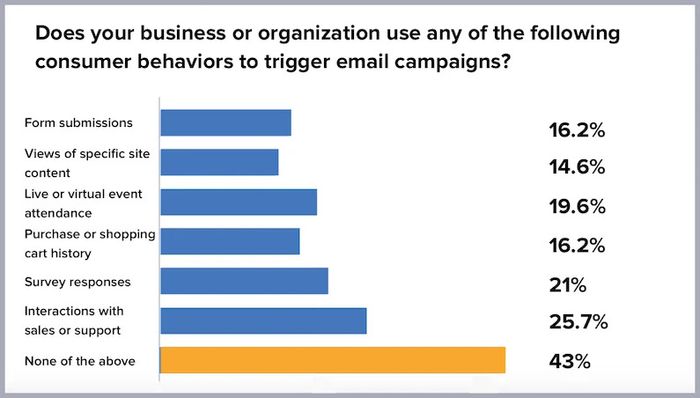
Essential Triggered Email Flows
In this section we are going to take a look at the essential triggered email flows and see what are the benefits of triggered email marketing.
Welcome Emails
Everyone appreciates a warm welcome. While it’s not possible to reach through the screen and shake your new customer’s hand, there’s no need for this to feel impersonal. A genuine and trust-building welcome email can create the perfect first impression.
Create your template using our email template builder.
Best Practices:
- Think of this as welcoming someone into your store and thanking them for choosing you. Adding a personal touch can go a long way in making your email feel authentic.
- Your brand identity is something you’ve worked hard to build, so why not share a bit about it in your welcome emails? Introduce your brand’s values and mission to give customers a sense of who you are and what you stand for.
- Using clear calls-to-action (CTAs) can guide your customers toward desired actions, such as exploring your website, downloading a resource, or making a first purchase. Including a well-placed CTA in your welcome email can be highly beneficial.
Benefits:
- In any successful relationship, communication is key—this holds true for business communications as well. Establishing a tone of open communication in your welcome emails initiates familiarity, making customers more likely to reach out with questions or concerns in the future.
- Engagement may seem like a buzzword, but it’s essential for building trust. Welcome email templates are an excellent opportunity to establish that trust and set the stage for future interactions.
Abandoned Cart Emails
It’s not uncommon for potential customers to forget about their purchases—shopping can sometimes feel overwhelming. As a business, you can gently and professionally remind them of their abandoned carts to reengage their interest.
Create your template using our email template builder.
Best Practices:
- There’s a saying: remind people of what they’re missing. Highlight the items left in the cart with appealing visuals to catch their attention.
- Here’s an insight into the customer’s mindset: even if a product is desirable, additional costs like shipping fees might deter them from completing the purchase. Offering incentives such as free shipping or discounts can help draw them back to their cart.
- Psychological cues are valuable tools in marketing. Phrases like “out of stock,” “your cart is waiting,” or “limited stock available” create urgency and can prompt action. Why not use these tactics to reengage customers with their abandoned carts?
Benefits:
- Trigger email marketing allows you to send timely emails after products have been sitting in carts for a certain period, helping recover potential lost revenue.
- Additionally, focusing on conversion rates can positively impact your sender reputation. Turning abandoned cart emails into sales not only boosts revenue but also simplifies your marketing efforts.
Post-Purchase Emails
Create your template using our email template builder.
To become a successful business owner, it’s crucial to understand the customer journey experience. Trigger based email marketing doesn’t end when a purchase is completed. By maintaining contact with your customers, you can enhance their experience and encourage repeat purchases.
Best Practices:
- Emails serve as written documentation for legal purposes, making them ideal for including confirmation details and shipping updates. Providing this information demonstrates your commitment to the customer agreement.
- If you offer accessories or product modifications, post-purchase emails are a great opportunity to suggest complementary items for upselling.
- Use this email as a chance to gather real-time feedback from your customers. Hearing directly from them can help you identify areas for improvement and grow your business.
Benefits:
- Post-purchase emails in trigger email marketing foster customer loyalty by providing valuable information about their order. This builds trust and strengthens your relationship with them.
- Think of how we all have stores our families trust and return to regularly. Maintaining post-purchase communication with your customers can create a similar connection, encouraging repeat purchases and long-term loyalty.
Re-Engagement Emails
Acquiring new customers through marketing campaigns is undoubtedly beneficial for your business. However, it’s equally important to focus on your existing customers. To win back inactive customers and renew their interest, you can trigger an email to be sent automatically after a set period, such as a few weeks or months.
Create your template using our email template builder.
Best Practices:
- There’s a saying in marketing: success is truly measured by a customer’s second purchase. To encourage this, personalize your emails using the recipient’s name and referencing past interactions to reestablish engagement.
- Loyal customers deserve recognition. Celebrate your connection by offering exclusive deals or sharing updates on new features as a way to show your appreciation.
- First impressions matter, even in re-engagement emails. Use captivating subject lines like “We miss you” or “Your favorites are waiting” to spark curiosity. Maintaining a genuine tone in these emails can lead to new purchases or a stronger, more trusting relationship.
Benefits:
- Losing customers who no longer buy from you is disheartening, but re-engagement emails can help reduce churn rates and reconnect with them.
- Remember, these customers showed interest in your business at some point. Rekindling that interest through thoughtful and engaging emails is a simple yet effective way to bring them back.
Behavioral Emails
Create your template using our email template builder.
Consumer behavior can serve as a valuable foundation for creating triggers, such as milestones or segments based on their shopping habits.
For example, if a customer frequently abandons their cart, you can use this behavioral trigger to send them a reminder email with a personalized discount or an offer to encourage them to complete their purchase.
They’ll likely appreciate these personalized messages, as they already enjoy your products but also value incentives like discounts or free gifts.
Best Practices:
- Recommending products based on their recently viewed items is a powerful strategy. However, always keep ethical considerations in mind when using customer data.
- For example, if a customer reads the blog post "The Best Fonts for Email Banners," you can use this behavior as a trigger to send them a follow-up email with a curated list of professionally designed email templates available on Tabular.email.
- Additionally, the email body should be as compelling as the visual elements. To maintain relevance, use dynamic content and update your text periodically to align with current trends.
Benefits:
- Behavioral triggers in email marketing enable deeper personalization by leveraging data directly from your customers.
- By using their personal behavioral habits, you can drive higher engagement and ultimately increase sales. Moreover, this approach allows you to send post-purchase emails, helping you build long-lasting relationships with your customers.
Birthday and Holidays
People love receiving emails or phone calls on their birthdays—it’s a day dedicated to celebrating them, after all. Why not use this occasion to strengthen trust and familiarity in your relationship with the customer?
Celebrating your customer’s milestones not only builds loyalty but also enhances your connection.
Create your template using our email template builder.
Additionally, you can create templates tailored to specific holidays or milestones, such as festive themes. A simple touch, like addressing their name in the email, can make the greeting feel personal and genuine.
Offering something special, like a Santa gift card with an exclusive offer, would likely be well-received as well.
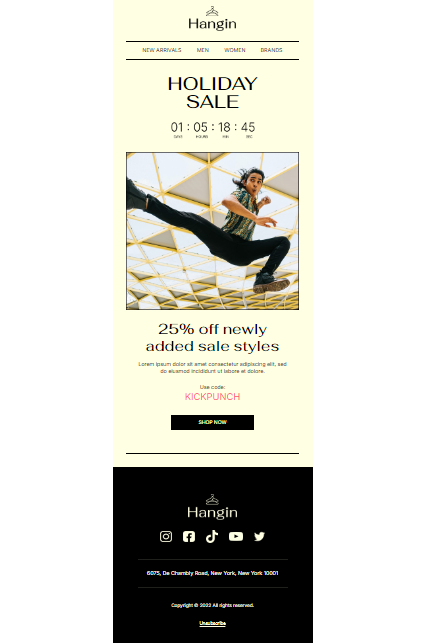
Advanced Triggered Campaigns
- Communicating with your customers solely for purchase-related reasons can feel overwhelming to them. To balance this, you can send event-based emails for webinars, promotions, or other educational content. Newsletters are great examples of this, as they offer users value in a more informal and engaging way.
- Expressing appreciation for the time they’ve spent with you is also a great opportunity to celebrate their loyalty. You can update them on loyalty programs, milestones, and even offer rewards like gift cards or free shipping labels.
- Occasionally, it's a good idea to remind customers about subscription renewals to prevent inactivity. Inactive accounts can negatively impact your sender reputation, so these reminders help maintain engagement and keep your emails effective.
- Lastly, it's survey time! Asking for feedback not only provides valuable insights into your company but also helps you learn more about your customers’ needs. It’s a win-win situation and shows your customers that you genuinely care about their engagement.
Create your template using our email template builder.
Strategies for Implementing Triggered Email Campaigns
- Map the Customer Journey: If you're unsure where to start, identifying the key touchpoints where triggers make sense is essential. Although it might seem overwhelming at first, once you’ve mapped the customer journey, you can easily follow the steps and place triggered emails at each relevant point.
- Use Data Effectively: In e-commerce email marketing, leveraging data is crucial. Use behavioral or demographic data for segmentation, enabling you to send more targeted emails that align with customer preferences and needs.
- Write Engaging Copy: When sending emails, it’s important to respect your customers' time. Overloading them with content and educational information can be frustrating, so focus on sending clear, concise, and personalized messages that create quality and engaging copy.
- Optimize Timing: Think about the times when you wouldn't want to contact someone, like emailing your professor about an exam at midnight. Similarly, optimize your email timing to reach customers at the most impactful moments of the day or based on your workflow.
- Test and Refine: The internet provides a unique opportunity to test your ideas and workflows. Continuously A/B test elements such as subject lines, content, and CTAs to identify the most effective strategies for your brand.
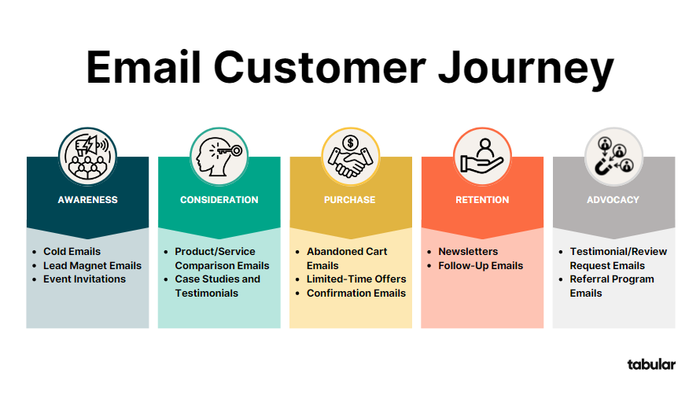
Common Mistakes to Avoid
- Even though sending emails or utilizing triggered email marketing can yield positive results, it's important to avoid overwhelming users with too many emails. Bombarding them with frequent messages can make it seem like you're spamming their inboxes, which could negatively impact your sender reputation.
- In today’s digital age, prioritizing data privacy is essential for any business. You must adhere to data privacy regulations and assure your customers that you are committed to safeguarding their information.
- Investing time in creating quality content shows respect for your customers. With the rise of AI tools, it’s easier to send generic, non-personalized messages. However, it's crucial to craft engaging and attention-grabbing content that still carries personal touches, making it more relevant and interesting to your audience.
Tools for Triggered Email Marketing
When it comes to automating your email marketing campaigns, choosing the right tool is essential. Here’s an overview of some popular options and their key features to help you decide which one aligns with your business needs:
| Tool | Best For | Key Features | Who It’s For |
|---|---|---|---|
| Klaviyo | Behavioral segmentation | Advanced automation, integration of behavioral and demographic data | E-commerce businesses, mid to large-sized |
| Mailchimp | Beginners & small businesses | User-friendly interface, pre-built templates, and workflows | Small businesses, startups, non-technical users |
| ActiveCampaign | Advanced automation & CRM integration | CRM integration, complex workflow automation | Businesses needing CRM and advanced automation |
| Omnisend | E-commerce & multi-channel campaigns | Multi-channel messaging (email, SMS, etc.), e-commerce triggers | E-commerce stores, businesses using SMS marketing |
| Tabular.email | Designing email templates with integrations for most ESP platforms | Creating email templates with dynamic content and high compatibility across email clients | Businesses targeting different stages of the customer journey |
Pro Tip: When selecting a tool, consider factors like ease of use, integration options, and scalability. Many platforms offer free trials, so you can test them out before committing. Always make sure that the tool aligns with your business goals and customer needs.
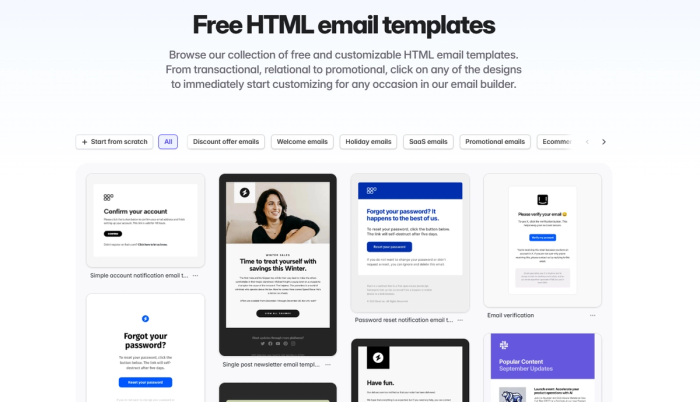
Successful Triggered Email Campaigns
Since we have covered up what email marketing trigger journeys are, it is time to support this blog with some examples. So, what are examples of email triggers?
Omaha Steaks Birthday Emails
Integrating food delivery services with personalized experiences is a growing trend. Omaha Steaks, a leading provider of premium steaks and gourmet foods, has successfully used birthday email campaigns to send personalized greetings and exclusive discounts to their customers. By tapping into emotional connections, they’ve managed to increase engagement and customer loyalty.
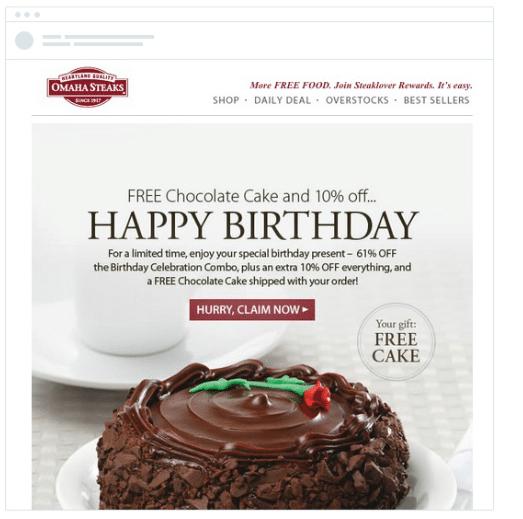
After all, who wouldn’t love receiving a premium steak or gourmet food as a birthday gift?
By using customers' birthday data, Omaha Steaks created a triggered email system to offer special deals making their customers’ birthdays even more enjoyable with their favorite gourmet food brand.
Welcome to the Rochester Lilac Festival
One key skill that festival organizers must master is effective communication with their customers at every stage.
Festivals are all about creating community, networking, and making sure everyone enjoys the experience. The Rochester Lilac Festival is a great example of using triggered email marketing campaigns with personalization to build meaningful relationships with their audience.
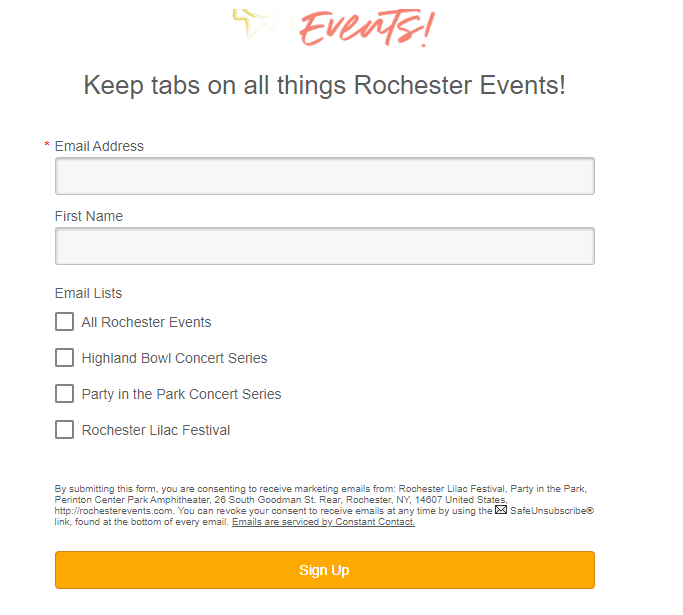
By tailoring their communications to personal interests, they were able to grow their email list by 14% year-over-year. Additionally, they saw a 7% increase in open rates.
Proving that their personalized, triggered emails were highly successful. In the end, this approach allowed them to foster long-lasting, trust-building relationships with their customers, who could enjoy the festival knowing the organizers truly care about them. It sounds like a lilac paradise, doesn’t it?
Measuring Success in Triggered Email Marketing
- Open Rates: The first metric you should focus on is open rates, which measure how engaging your subject lines are. After all, we all judge a book by its cover. Since the subject line is the first thing a customer sees, it’s essential to craft attention-grabbing hooks that encourage them to open the email.
- Click-Through Rates: The goal of sending triggered email marketing campaigns is often for the recipient to click on the CTAs, such as downloading an ebook or making a purchase. Tracking click-through rates lets you assess how many users interacted with your email content.
- Conversion Rates: Converting email communication into actual purchases hinges on your ability to create clear CTAs and engaging campaigns. Therefore, focusing on conversion rates allows you to assess how effectively your emails drive the desired actions.
- Bounce Rates: Even if you send out the most interesting email, a high bounce rate means recipients are not engaging with your email content, which can negatively impact your campaign. Analyzing bounce rates helps you identify potential issues in segmentation or content and optimize subject lines or offers to better attract attention.
- Revenue Generated: Return on investment (ROI) is crucial, so measuring the direct sales generated from your email campaigns shows how successful your trigger email marketing strategy truly is. This is the ultimate indicator of how well your efforts are paying off.
Other Optimization Tips
- We wish we could tell you that once everything is planned, you can just sit back and relax while your trigger emails send themselves. However, one thing you must not overlook is the regular analysis of performance metrics. You should continuously evaluate the data and update your content accordingly. Think of it like using outdated phrases—like calling something "cool" when talking to Gen Z. It could make your communications seem out of touch with your audience.
- As we’ve seen in our examples, personalization plays a key role in successful trigger email marketing. By adjusting email frequency based on user preferences, you can create a more beneficial experience for both you and your customers. In simple terms, we don’t want you to become like an aunt who calls every day without getting a response.
- Staying proactive and experimenting with new triggers can unlock new workflows and opportunities for better conversions. Regular testing, optimization, and identifying high-performing strategies will ensure your email marketing continues to improve and drive results.
Wrapping Up
In effective email marketing, automation and personalization are key elements that simplify your efforts. Long story short, they are great advantages that e-commerce offers us. With a well-planned workflow, trigger email marketing enables you to connect with recipients at every stage of their customer journey.
These strategies enhance customer engagement and drive higher conversions, fostering long-lasting loyalty in relationships. By investing in triggered email campaigns, you can ensure timely and meaningful interactions with your recipients whenever they need you. With the right tools and a personalized approach, your business can significantly boost email marketing performance.
We hope this blog has provided you with valuable insights into customizing your content and creating efficient workflows for your business. With trigger-based email marketing, we’re confident you can achieve a more impactful, customer-centric strategy. Happy emailing!